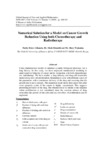Numerical Solution for a Model on Cancer Growth Reduction Using both Chemotherapy and Radiotherapy
| dc.contributor.author | Gikunda, Purity Kioro | |
| dc.contributor.author | Kimathi, Mark | |
| dc.contributor.author | Wainaina, Mary | |
| dc.date.accessioned | 2019-10-09T09:15:44Z | |
| dc.date.available | 2019-10-09T09:15:44Z | |
| dc.date.issued | 2019 | |
| dc.identifier.issn | 0973-1768 | |
| dc.identifier.uri | http://ir.mksu.ac.ke/handle/123456780/4902 | |
| dc.description.abstract | Using mathematical models to simulate dynamic biological processes has a long history. In this study, we have employed mathematical modeling to understand the behavior of cancer and its interaction with both chemotherapy and radiotherapy .We have studied a drug delivery and drug-cell interaction model along with cell proliferation. Simulation is done with different values of the parameters with a continuous delivery of the drug and assuming that the growth rate is not a constant. The numerical result shows that cancer dies after short apoptotic cycles if the cancer is highly vascularized. This suggests promoting perfusion of the drug. The obtained result is similar to the situation where proliferation is not considered since the constant release of drug overcomes the growth of the cells and thus the effect of proliferation can be neglected. | en_US |
| dc.language.iso | en_US | en_US |
| dc.publisher | Research India Publications | en_US |
| dc.title | Numerical Solution for a Model on Cancer Growth Reduction Using both Chemotherapy and Radiotherapy | en_US |
| dc.type | Article | en_US |
Files in this item
This item appears in the following Collection(s)
-
School of Pure and Applied Sciences [259]
Scholarly Articles by Faculty & Students in the School of Pure and Applied Sciences

